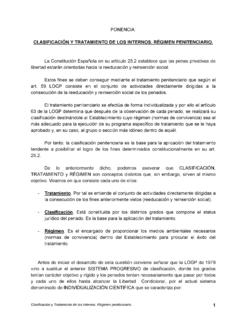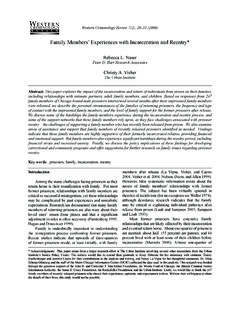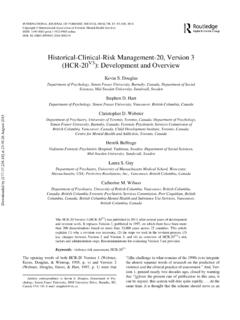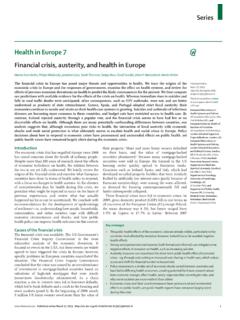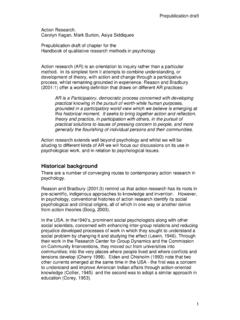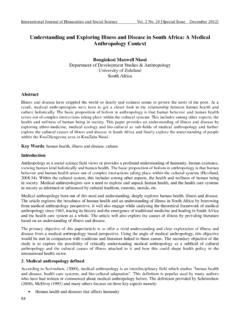Transcription of Restorative Justice: What is it and Does it Work?
1 Georgetown University Law Center Scholarship @ GEORGETOWN LAW. 2007. Restorative justice : what is it and Does it Work? Carrie Menkel-Meadow Georgetown University Law Center, Georgetown Public Law and Legal Theory Research Paper No. 1005485. This paper can be downloaded free of charge from: 3 Ann. Rev. L. & Soc. Sci. 161-187 (2007). This open-access article is brought to you by the Georgetown Law Library. Posted with permission of the author. Follow this and additional works at: Part of the Criminal Law Commons, Dispute Resolution and Arbitration Commons, and the International Law Commons ANRV327-LS03-10 ARI 13 July 2007 21:27.
2 V I E W. E. R. S. C E. I N. N. A. D V A. Restorative justice : what Is It and Does It Work? Carrie Menkel-Meadow Georgetown University Law Center, Washington, DC 20001;. email: Annu. Rev. Law Soc. Sci. 2007. 3 Key Words The Annual Review of Law and Social Science is reconciliation, reintegration, community, victims, offenders, online at criminal law, crime and punishment, human rights, reparations, This article's doi: international law Copyright c 2007 by Annual Reviews. Abstract All rights reserved This article reviews the now extensive literature on the varied arenas 1550-3585/07/1201-0001$ in which Restorative justice is theorized and practiced criminal vio- lations, community ruptures and disputes, civil wars, regime change, human rights violations, and international law.
3 It also reviews by examining empirical studies of the processes in different settings . how Restorative justice has been criticized, what its limitations and achievements might be, and how it might be understood. I explore the foundational concepts of reintegrative shaming, acknowledg- ment and responsibility, restitution, truth and reconciliation, and sentencing or healing circles for their transformative and theoretical potentials and for their actual practices in a variety of locations . family abuse, juvenile delinquency, criminal violations, problem- solving courts, indigenous-colonial-national disputes, ethnic and religious con icts, civil wars, and liberation struggles.
4 Restorative justice , which began as an alternative model of criminal justice , seeking healing and reconciliation for offenders, victims, and the communities in which they are embedded, has moved into larger na- tional and international arenas of reintegration in political and ethnic con icts. This review suggests that there are important and serious questions about whether Restorative justice should be supplemen- tal or substitutional of more conventional legal processes and about how its innovations suggest potentially transformative and challeng- ing ideas and moves for dealing with both individual and group transgressive conduct, seeking peace as well as justice .
5 ANRV327-LS03-10 ARI 13 July 2007 21:27. INTRODUCTION: CONCEPTS, poses and nature of wrongdoing and punish- DEFINITIONS, AND PURPOSES ment (Gabbay 2005, Blumenson 2006) and is OF Restorative justice only brie y reviewed here. At both the philo- sophical and sociological level, Restorative jus- To its conceptual and practical founders tice raises important questions about who (John Braithwaite, Howard Zehr, and Mark should have power, control, and possession Umbreit, among others), the eld of restora- over crime, acts of wrongdoing, punishment, tive justice is an effort to transform the way we restitution, reconciliation, and community in- think of punishment for wrongful acts.
6 When terests (Christie 1977, Menkel-Meadow 1995, a crime or serious bad act (which may include Von Hirsh 2003). When an act of wrong- more classes of activity than those legally la- doing is committed, who has an interest in beled criminal) occurs, it effects the victims, its recti cation: the victim, the community, offenders, interested bystanders (such as fam- the offender, those affected by the act, or ily members, employees, or citizens), and the the larger society? Who decides what jus- larger community in which it is embedded. To tice is: the victim (who might want vengeance paraphrase one of the eld's founders (Zehr or restitution), the state (who will want to 2002, Zehr & Mika 1998), these bad acts or deter future crimes and acts of wrongdoing, ruptures in human interaction create needs set precedents for others, and establish so- and responsibilities for the direct participants cial control), or the community in which the in the act, as well as for the larger society wrongdoing is embedded (where motivations in which their act(s) occur.)
7 Restorative jus- may vary from revenge to the desire to re- tice is the name given to a variety of differ- claim every community member)? Who has ent practices, including apologies, restitution, the power to forgive and accept restitution or and acknowledgments of harm and injury, reconciliation: the victim, the victim's family, as well as to other efforts to provide heal- the community in which the wrong occurred, ing and reintegration of offenders into their or the state? what if acts of wrongdoing af- communities, with or without additional pun- fect both individuals and a larger commu- ishment.
8 Restorative justice usually involves nity, such as hate crimes or genocides? If direct communication, often with a facilita- crime or other acts of wrongdoing are a col- tor, of victims and offenders, often with some lective hurt or tear in the social fabric, can or full representation of the relevant affected individuals forgive on behalf of anyone be- community,1 to provide a setting for acknowl- sides themselves? Are crime victims adequate edgment of fault by the offender, restitution proxies for the rest of a society that may of some sort to the victim, including both af- de ne justice differently (more harshly, less fective apologies and material exchanges or harshly)?
9 How are we to know what the proper payments, and often new mutual understand- unit of analysis is for measuring appropriate ings, forgiveness, and agreed-to new under- forms of punishment or restitution? what is takings for improved behaviors. In its most the proper balance between victim-offender idealized form, there are four Rs of Restorative reconciliation, community peace, and social justice : repair, restore, reconcile, and reinte- order or justice ? (Similar issues have been grate the offenders and victims to each other raised in the civil sphere of dispute process- and to their shared community.)
10 Ing; see Menkel-Meadow 1995, 2006.) How Restorative justice raises deep philosoph- should we integrate both the public and pri- ical, sociological, and empirical issues. The vate aspects of crime and wrongdoing? Should philosophical literature focuses on the pur- right-making of wrongdoing be backward fac- ing (punishment and legal justice ) or future 1. The notion of what the community is in Restorative justice facing (reconciliation, restoration, and social is one of some controversy (Weisberg 2003). justice )? Menkel-Meadow ANRV327-LS03-10 ARI 13 July 2007 21:27. Whatever one's views on these impor- or wrongful acts, and, at its best, suggestions tant philosophical and criminological issues, for creative, tailored solutions.

